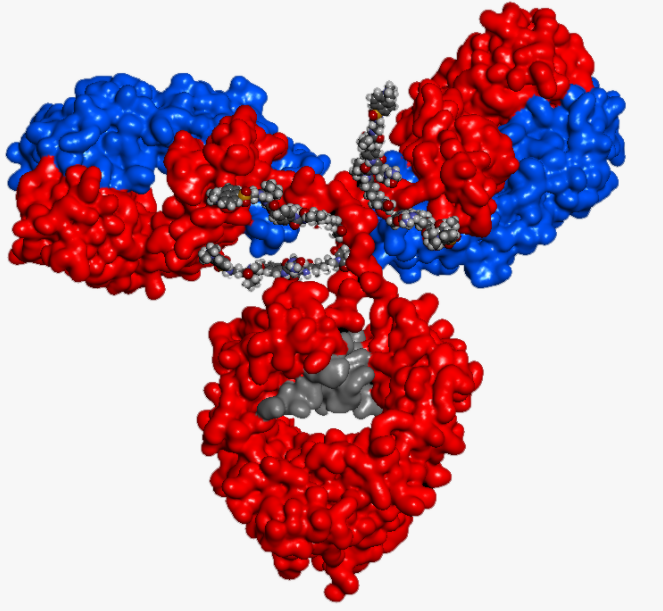Research Progress of Conjugate and Linker in Antibody-drug Conjugates (III)

Research Progress of Conjugate and Linker in Antibody-drug Conjugates (III)

Recently, Buchwald and colleagues developed a fast and highly selective cysteine conjugate using aryl palladium complexes. By mixing active palladium-phosphine complexes and various aryl halides, aryl palladium reagents can be easily prepared. The resulting complex undergoes sulfhydryl arylation in a rapid and selective manner, reducing the cysteine residues of the antibody. They demonstrated the potential of this new method to directly combine with the palladium complex of trastuzumab and vandetanib (kinase inhibitor), which provides a linkerless ADC with a DAR of 4.4. Although the obtained ADC has no linker, its binding affinity to recombinant HER2 (Kd = 0.1–0.5 nmol/L) is comparable to the parent trastuzumab. Another advantage of this method is that the resulting aryl-cysteine conjugate is stable to acids, bases, oxidants and externally added mercaptans. Although this method is unique and interesting, it requires major modifications or improvements in some key factors for future clinical applications (palladium toxicity, post-processing strategies to completely remove palladium, cost of palladium complexes, control of DAR, etc.). Despite the current limitations, further work will provide researchers with insights based on cysteine coupling chemistry and rational design of reagents used to prepare ADCs, which may not be constructed using traditional methods.
Introducing genetic engineering into unnatural amino acids
The installation of unnatural amino acid residues through the reaction arm is a strategy that can achieve chemical coupling at specific locations, resulting in strict control of DARs. Schultz and colleagues developed a protein expression system (bacteria, yeast, and mammalian cells) in which a unique codon-tRNA synthetase was introduced to genetically encode paraacetyl phenylalanine containing a carbonyl group. Either expression system can be used to produce engineered antibodies containing p-acetylphenylalanine residues, and the introduced carbonyl group can be reacted with an alkoxyamine functionalized linker to provide an oxime-conjugated ADC. Other examples are p-azidomethyl-L-phenylalanine and N6-((2-azidoethoxy)carbonyl)-L-lysine. The incorporated azide group is coupled to an alkynyl-functional linker through a copper-catalyzed Whissian cycloaddition reaction (commonly referred to as "click chemistry") to provide a triazole-linked ADC. Zimmerman et al. using this method, monomethyl auristatin F (MMAF) is conjugated with trastuzumab, thereby providing an effective ADC. All functional groups in the antibody sequence can tolerate both binding reactions. Therefore, DAR can be strictly controlled by adjusting the degree of incorporation of unnatural amino acids and making full use of the incorporated reaction arms for coupling. Bioorthogonal conjugation of azide-incorporated antibodies can be achieved by using strained cyclooctyne functionalized linkers that do not require cytotoxic copper oxide catalysts. However, methods based on unnatural amino acids usually require special techniques and biological reagents for genetic engineering, and the incorporated unnatural amino acid residues may cause adverse immune responses. Further efforts to solve such problems will make this method truly practical and versatile in the industrial production of ADCs.
Enzyme conjugation
Several enzymes have been used to couple natural or genetically engineered antibodies to payloads, or to install unique reaction arms on antibody scaffolds for later chemical coupling. These enzymes modify antibodies in a specific way in terms of sites or amino acid sequences. In addition, the reactive sites in the natural mAb or handles introduced by genes are designed to specifically react with the corresponding functional groups. Therefore, (chemical) enzymatic methods usually allow site-specific binding, resulting in tight control of DARs.
Transpeptide using sortase
Transpeptide using microbial transglutaminase
N-glycoengineering
The Asn297 (N297) in the Fc domain and the N-glycan on this residue are conserved in all IgG classes, making these components attractive reaction sites that can be widely used in ADC coupling. Zhou and colleagues developed a method using β-1,4-galactosyltransferase (GalT) and α-2,6-sialyltransferase (SialT) to incorporate aldehyde groups at the end of N-glycans. These two enzymes introduced sialic acid at the end of each N-glycan, which was then converted to aldehyde groups using NaIO4 under mild oxidizing conditions. The resulting aldehyde groups are then used to conjugate aminooxy functionalized payloads. In their study, the average DAR of this conjugation method was 1.6, roughly the same as the number of sialic acid residues introduced by each antibody. Unfortunately, the oxidation step using NaIO4 can oxidize the methionine residues in the antibody, and due to the low conversion rate, the DAR distribution is wider. Another method is to incorporate non-natural sugars with orthogonal reaction handles into antibodies. One of the latest technologies based on this strategy is the GlycoConnect technology developed by van Delft and his colleagues. The endoglycosidase Endo S2 was used to trim the glycan chain of Asn297, and then the mutated galactosyltransferase GalT (Y289L) and N-azidoacetylgalactosamine (GalNAz) were used to introduce the azide group. The azide handle is used for the strain-facilitated click reaction of the payload, thereby producing a stable and uniform ADC with a tightly controlled DAR (2 in most cases). The biggest advantage of this technology is that it provides consistent results regardless of the heterogeneity of the N-glycan form, which means it can be used with any IgG isotype with various N-glycosylation profiles.
To be continued in Part IV…